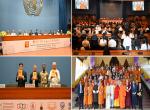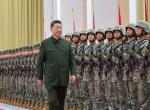There were considerable enthusiasms in Pakistan prior to President Asif Ali Zardai’s visit to China which ended with much less triumph because the two main areas of negotiations, namely, civil nuclear energy cooperation and China-Pakistan railway links did not bring out the expected results. Any agreement on civil nuclear energy between the two countries, if signed in future, will not only affect India, but also damage China’s credibility with developed countries zealously safeguarding the status quo of the global nuclear non-proliferation regime. The Chinese leadership has showed prudence by maintaining silence during Zardari’s visit on this respect. Another agenda of Zardari’s visit, the China-Pakistan rail link through Pakistan-occupied Kashmir (POK), which was deliberated by the leaders of the two countries, also has serious strategic implications for India.
By the turn of the new century, Pakistan authority realized that the age old British-made railway system of the country needed immediate attention. They began to take up various up gradation projects and sought collaboration with China in this sector. In 2001 China provided Pakistan with a fund of 250 million dollar and in 2003 it again spent 500 million dollar for several railway projects. About the same time China began to invest funds and technical expertise in the construction of a deep water port at Gwadar on the bank of Arabian Sea. In 2002, construction work of a trans-boundary railway link connecting southeastern city of Kerman in Iran and Zahedan in the Pakistan border was taken up. To meet China’s vision of a global power, in 2004 it began to examine strategic implications of three ambitious railway links of which two are transnational, proposed to be connected with Pakistan and Myanmar.
It was during Gen. Musharraf’s China visit in February 2006 that he repeatedly mentioned about the construction of an energy corridor (能源走廊) between China and Pakistan. It appears that successful construction of the Qinghai-Tibet railway line gave impetus to proceed with the plan of building China-Pakistan rail link. During Gen. Musharraf’s visit to China in April 2008, he proposed a plan of constructing a rail link between Kashgar in Xinjiang and Gwadar port. Along with this it was also proposed that an oil pipe line be constructed between the Middle East countries and Pakistan. The proposed railway will follow the same route as the illegally constructed Karakoram Highway that passes through Gilgit-Baltistan region of the POK. The total length of the line will be around 700 km and it will connect Kashgar with Havelian in the vicinity of Rawalpindi. The railway line will cross China border at Khunjerab pass which is situated more than 4000 meters above the sea level and about 150 km away from the county town.
According to a recently published report based on an interview with a scholar of Xinjiang Academy of Social Sciences Pan Zhiping, this railway will help China to completely abandon the Malacca Strait, the only sea route through which Chinese vessels bring in more than 80 per cent of its required petroleum from Middle East and Africa. Since China does not have any hold over the Malacca strait, it is worried of being cut off from these oil exporting countries if any war breaks out. This is what the Chinese call the Malacca dilemma (马六甲困局). The report also states that China and Pakistan over a number of times have examined the feasibility of this rail link, but the future of the projects does not appear to be bright at all.
The Chinese railway construction experts think that it would not be difficult to finish construction of a rail link up to the Iranian capital Tehran within 2015. The main constrain of the project is economic. Some experts even questioned the strategic wisdom of taking up an expensive project on the basis of a premise that China needs an alternative oil transportation route in case of any war in the future. It is possible that there might never be such a war. It is naïve to think that those who would block China’s oil supply route in the Malacca strait would allow oil tankers to move freely by the transnational railway running through the strategic passes and politically volatile regions. Moreover, both transportation cost as well as freight charges on the transnational border land by railways are more expensive than that of sea route. According to one estimation, the cost of freight transport per container of goods from China’s Lianyugang to Rotterdam by New Europe-Asia Continental Bridge (新欧亚大陆桥) is somewhere between US$ 3500 and 4800, where as it comes around US$ 1000 to 1500 per container by sea route albeit the distance is double than that of the railway. In addition, due to complications in the land transportation, it takes 23 days more in rail than by the sea route. Xia Yishan, a Central Asian expert of Chinese Institute of Contemporary International Relations (中国现代国际关系研究院) also shares this view. In his opinion, a rail link exclusively constructed for carrying petroleum will not have any significance if it cannot transport ten million ton of crude oil in a year, which would definitely be more than the carrying capacity of the proposed railway.
There is a view which however contends that a railway link would increase the capacity of transporting huge amount of goods and reduce the overall cost of transportation that the existing Karakoram Highway is unable to meet. In order to increase the load carrying capacity, China has already planned to expand the width of a 335 km long stretch of the highway running between Khunjerab and Raikot from 10 meters to 30 meters. This is sure to satisfy the present need of trade on this road. It would be a mistake though if Pakistan considers that the proposed railway line would substitute the oil & gas pipe line and electric cables. The military establishment in Pakistan, however, reckons that the rail link will help China’s military industry, because the former is a huge market of arms trade. At present Pakistan imports about one billion dollar of arms and ammunitions and this figure is expected to be redoubled by 2015.
During Zardari’s last visit, leaders of both sides had discussed on the construction of railway and highway net works between the two countries as well as feasibility of the oil & gas pipe lines. Pakistan President also discussed the phases of implementation of the various projects with the Chinese side. Both sides have decided to set up a joint working group comprised of big oil and natural gas companies, consultation agencies, engineering and construction groups, and investment banks. However, it appears that there was no concrete discussion on the China-Pakistan rail link.
On July 8, Chinese Foreign Ministry Spokesman Qin Gang said that cooperation with Pakistan in the construction of rail-link between the two countries would result in mutual benefit and common victory (互利共赢). Evidently to assuage the Indian apprehension, he reiterated the stereo-typical phrase of “not directed towards any third country” (不针对第三方).
There is still a section of Chinese scholars and experts who see the economic and strategic benefits of the China-Pakistan rail link. According to their view, the rail link will ensure steady and secure flow of oil and gas from the Middle East to the centers of economic activities in the eastern part of the country. This will help Pakistan and Iran to acquire materials, capitals and substantial military and strategic support from China. When China will start getting a steady supply of petroleum from the Middle East, it will have an advantage in negotiating with Russia in the areas of oil and gas. This rail link will also serve as a huge artery of economic activities (一条经济大动脉) and transportation line of strategic materials (一条站略物质运输线). According to this point of view, India might be able to see the opportunities in the China-Pakistan oil cooperation and join in this economic game, and by doing this it will not completely tilt towards USA.
The Chinese official media dismissed Indian concerns as a reflection of the wide spread sentiment of ‘China threat’ prevailing in the country. India, however, has a greater number of Sinophiles than that of Sinophobes. Neither the theory of ‘imminent collapse of China’ nor ‘China threat’ is an Indian home grown concept. However, the proposed railway link between China and Pakistan impinges upon India’s sovereignty as POK is an internationally recognized disputed region rightly claimed by India as its integral part. Pakistan does not have any right over this piece of land.
Sources:
联合报:中巴研拟铁路直通阿拉伯海 战略意义大
http://www.chinanews.com.cn/hb/2010/07-09/2391955.shtml (09/07/10)
印度过分敏感中巴铁路传言 扬言采取对抗措施
http://world.huanqiu.com/roll/2010-07/914818.html (09/07/10)
想到为什么现在还不开始修中巴喀喇昆仑铁路呢?http://www.wyzxsx.com/Article/Class20/200911/113230.html (12/07/2010)
专家担忧地质因素影响 对中巴铁路修建并不乐观
http://world.huanqiu.com/roll/2010-07/914867.html (09/07/10)
巴基斯坦欲修铁路直通中国 从赫韦利扬到喀什http://www.dzhanl.cn/viewthread.php?tid=8602&extra=page%3D (14/07/2010)
沿海、中巴、泛亚三大战略有急有缓,沿海铁路最有希望
http://www.sclxsz.com:7000/article/show.asp?id=53 (16/07/2010)
中国拟建三大战略铁路全球定位发生重要变局作者
http://www.china-tea.org/Html/200463093427-1.html?jdfwkey=ur3yf3 (16/07/2010)
巴总统扎尔达里将在访华期间讨论铁路开放政策
http://www.tieliu.cn/gwtl2/2010/201006/2010-06-30/20100630103650_242880.html (16/07/2010)
“中巴伊铁路”中国铁路直通波斯湾?
http://www.cn508.com/article.asp?/zyjlr$_$e71596168f405c51f3de32ad.html (17/07/2010)









Post new comment